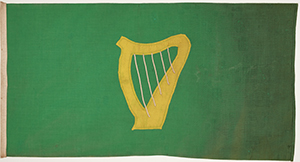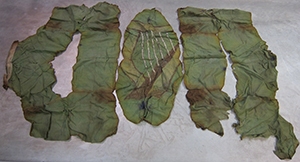James Connolly’s ‘Green Flag of Ireland’
Published in Issue 3 (May/June 2016), News, Volume 24OVER THE COURSE OF THE LAST FEW MONTHS AN AMAZING NEW DISCOVERY HAS COME TO LIGHT
By Rachel Phelan

Above: The Inniskillings Museum’s flag. The evidence suggests that this is Connolly’s ‘Green Flag of Ireland’ under which the Citizen Army formed up to march on the GPO in 1916. Unlike the other 1916 rebel flags it has not been on long-term display, and the brightness of the colours gives some idea of what the others must originally have looked like. (Inniskillings Museum)
Over the last few years I have examined many different flags and was not at all hopeful. Nevertheless, on first assessment this flag bore multiple similarities to the existing 1916 Dublin garrison flags. James Connolly is recorded in multiple sources as holding an elaborate ceremony with the Irish Citizen Army on Palm Sunday 16 April 1916, in which ‘the Green Flag of Ireland, emblazoned with the Harp without the Crown, as the sacred emblem of Ireland’s unconquered soul’ was hoisted over Liberty Hall by Molly O’Reilly. This was the first occasion that Connolly appeared in uniform, and a full description of the ceremony is given in the last edition of the Workers’ Republic, 22 April 1916.

Above: The National Museum’s green harp flag. Earlier this year all the main pieces were laid out and examined, including by experts from the Garda Forensics Unit. Using the mirrored burn damage as a guide, the fact that this flag had been folded when it was burnt was clearly established. (NMI)
The National Museum, however, already had a green harp flag that was taken from the ruins of Liberty Hall by a British officer. It has traditionally been credited with being the flag that was raised over the building. In six burnt fragments, the flag is a pale green wool and of amateur construction, with a brown harp roughly painted on both faces. This design would not have been clearly visible when flown and is not in keeping with the work of a skilled seamstress. More important was the pattern of fire damage throughout the sections. Earlier this year all the main pieces were laid out and examined together with experts from the Garda Forensics Unit. Using the mirrored burn damage as a guide, the fact that this flag was folded when it was burnt was clearly established. All three main pieces interlink with a ‘stacked burn pattern’. Connolly is recorded as having a stash of flags and as having sent back to Liberty Hall for more. The National Museum flag would appear to have been left folded in the building and damaged when it was destroyed.
The Inniskillings Green Harp flag was brought down to the conservation studios for analysis. All elements of the flag were identified and examined microscopically, and further analysis was carried out in the State Laboratories. It is a tabby weave wool, as are all the Dublin 1916 rebel flags, and the manufacture, while good, is not of a professional standard, unlike many Volunteer flags. This would fit in with the narrative that Connolly had flags made by Ms Shannon of the Liberty Hall Clothing Co-Operative. The ground is a single-selvedge piece of bright green fabric with a gold harp appliquéd in the centre. The five harp strings are cut lengths of twill cotton tape, as could easily be found in a shirt-making workshop. In design and manufacture it is very close to the larger Marrowbone Lane flag currently on display in the National Museum.
The piece had been extensively moth-damaged and the holes were examined under photomicrograph. This unexpectedly revealed a single British .303 bullet hole in the top fly corner, which was compared against fabric shot by Garda Ballistics. While flags mark a building or territory, they are not generally a military target and the limited battle damage is in keeping with the other 1916 garrison flags outside Sackville Street. Examination of images of Liberty Hall before and after the Rising appears to show that the flag was hung from the Beresford Place/Eden Quay end, where it would have been clearly visible along the Liffey, and this is probably the reason for its survival. Flags placed at corners or at a height on a dome are less likely to be destroyed than those in the centre of a building.
All evidence to date would appear to indicate that the flag from the Inniskillings Museum is Connolly’s ‘Green Flag of Ireland’ under which the Citizen Army formed up to march on the GPO. Unlike the other 1916 rebel flags, it has not been on long-term display, and the brightness of the colours gives some idea of what the others must originally have looked like. It is currently on display as a long-term loan to SIPTU in Liberty Hall.
Rachel Phelan is a textile conservator and historian.
















